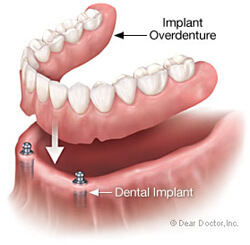Implant Overdenture
An implant overdenture connects to cylinder-like configurations (called implants) that have been surgically implanted into jaw bone.
The denture appears like a traditional prosthesis. However, that part of the denture overlying implants is modified to retain various semi-rigid attachments that receive implant extensions projecting above the gum. This arrangement helps keep a denture securely in place while eating, speaking and during other oral activities, but still allows easy self-removal of the denture for cleaning purposes.
There are two phases to this process. The first is a surgical phase consisting of two stages, and the second is a prosthetic phase (making the implant denture).

The surgical phase
1.Surgical insertion stage
- Implants are completely inserted into precise preparations in jaw bone. While there are various implant configurations, they are essentially cylindrical in shape and made of pure titanium metal. After implants are inserted into jaw bone, gum tissue over the implant is closed with sutures in most cases.
- While a minimum of two implants may be inserted for an acceptable outcome, a person may be treatment planned to receive three or more – – depending upon individual needs and anatomical limitations. More implants will give additional support and retention to the implant denture.
2.Healing and surgical exposure stage
- During healing, an existing or temporary denture may continue to be worn after adjustments have been made to adapt to the surgerized site. If the existing denture cannot be altered sufficiently, a provisional prosthesis should be fabricated.
- Implants are left undisturbed beneath gum tissue for at least several months as determined by the dental professional. During this time bone reorganizes and grows around the implant surface, anchoring it securely into the jaw (this is called osseointegration).
- At the end of the healing stage, the top of the implant is exposed by removing gum tissue directly over it. An extension that is then screwed into the exposed implant projects slightly above the gum tissue.
- After adjustments, an existing denture can be worn over an implant extension while the gum heals. However, the denture must be reshaped to conform to surgical site contours in order to avoid unnecessary pressure areas on the newly surgerized site.
The prosthetic phase (making the implant denture)
- A precision superstructure is fabricated that is screwed into the implant extensions. This superstructure may have various interface configurations ranging from interconnecting metal bars to specially shaped singular extensions.
- A denture is fabricated with special provisions on the inside surface to receive various types of attachments (interlocks). Depending on the attachment, they interact in various ways with the superstructure. For example, a metal or plastic attachment may clip onto metal superstructure bars, a nylon receptacle may receive a specially configured implant extension, and so forth.
- The attachment/superstructure configuration helps to securely maintain a denture while eating and speaking, and still allows a person to comfortably and easily remove the prosthesis for cleaning purposes.
Essential maintenance needs
As might be expected, exemplary oral hygiene is essential to helping prevent the development of disease around implants that could cause their failure.
Implants, superstructure, attachments and the overdenture must be checked and professionally maintained by a licensed dental professional on a regular basis. Attachments often need periodic adjustment or replacement due to wear.
While the implant overdenture approach is complex and expensive, the value received by an individual usually far exceeds monetary considerations.
How long will implant overdentures last?
An implant may last for a lifetime (current reports show many implants lasting twenty years) or deteriorate in a few years – – many factors are involved that reduce the life expectancy of implants, such as oral hygiene, general health, habits such as smoking, grinding, and so forth. The superstructure or implant extensions may need to be replaced after five years. Depending on the implant system used, some parts may need to be replaced annually, or sooner, because of wear or deterioration. These time frames are generalities. The dental profession continues to strive for long-term durability.
Best dental health advice and treatments from dentist dental implant process step by step process and surgery recovery procedure dental implant process
